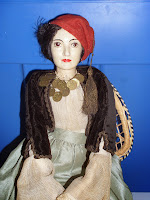Monday, August 25, 2014
Folk, Flower Dolls, a Theriault's Auction
Folk art is generally defined as art created by people not trained. They didn't go to art studio in college, or take classes at an art institute. Folk artists usually work with what they have, and are fond of assemblage and collage art. Grandma Moses is considered a folk artist in some circles [Incidentlaly, some dolls she made have turned up]. Many quilters, doll makers, potters, and sculptors fit the category, which often branches out into tramp art, convict art, and outsider art.
Folk dolls are made of found objects, can be sophisticated or crude, realistic, or not, depending on the artist's natural talent. The first doll had to have been a folk doll. Many experts theorize that a child picked up a stick or piece of bone that resembled the human figure, and, Voila! the doll was born. From the Stone Age come cave paintings and the Venus figures, and we don't know if early humans had art classes to learn how to make this type of art, but all of it began with one person's experimentation.
Ethnic art and all types of crafts have been defined as folk art, too, and the category has included national costume dolls, tourist dolls, all handmade dolls, cloth dolls, ethnic dolls, and carvings. Dolls made of unusual materials like dressed fleas [let me know if you have a set for sale out there!], dried apple dolls, cornhusks, rocks, and coal are also called folk dolls, though some are often made in factory settings, like the apple dolls of Isabelle Million [See Coleman's, "Collector's Encyclopedia of Dolls, Volume I"].
Teddy bears and worn plush toys are often considered folk art, ships figureheads, cigar store mascots, scarecrows, snowmen, primitive doll art and others are, too. The best book on the subject is Wendy Lavitt's, "American Folk Dolls."
Also, look for posts discussing my dolls made of plants and herbs, and my new paper dolls, "Herb's Daughters," debuted at a local herbal society gathering. I also discussed Hawthorne's story, "Rapaccini's Daughter" as a sort of doll/Frankenstein story. More to come on this subject. Remember, Nathaniel Hawthorne inspired House of Seven Gable dolls, and he is related to the hanging judge of the Salem Witch Trials, Judge Hathorne. Dolls or poppets were invovled in the trials, too, and I have a set of them made in Salem, as well the official broom of the Salem Witches.
Laurie Cabot, official Witch of Salem, also collects dolls.
Below is the press release for "An American Childhood" by Theriault's, a doll auction that features hand made and folk dolls. The italics are their words:
Theriault's . . . has a tradition of showcasing the myriad of genres within the world of dolls. Says Theriault's President Stuart Holbrook, 'Each and every collection speaks to the particular vision of the person who assembled those dolls. Yet, there are times when a collector's vision is so pure and focused, that we are left in amazement at the spectrum of dolls that fit within that view.'
One's first thought on viewing such a collection, Holbrook adds, "I never imagined . . ."
A the October 4-6 auction event in Los Angeles, California at the Universal City Hilton, collectors will have three days to pour over this concept when Theriault's presents a weekend entitled 'An American Childhood', highighted by the collection of the internationally-famous identical twin doll collectors, Valerie and Diane Blackler, whose vision was the quintessential American childhood from the mid-19th century to the first half ot the 20th century.
The Blackler twins began their joint collection during their own childhood with one particular focus: dolls that the average girl might carry west in covered wagons, dolls that evoked the simple past that is so beautifully arranged in their coastal home in Naples, California, seemed the very juxtaposition of their own classic "California Beach" persona with blonde bouncy ponytails and vibrant costumes and jewelry for which they were so famous in antique circles in Southern California.
'Sometimes collections mirror our obvious selves', says Florence Theriault, 'but sometimes they reflect something completely different and deeper...the opposite of the obvious.'
It is why, when people see this astounding collection it will be a completely different idea than what most collectors might have imagined as The Blackler Collection. The collection is one of the finest offerings of early American cloth and folk art dolls every to come to market, including an astounding collection of black cloth dolls, as well as dozens of fine teddy bears, Raggedy Ann and early studio dolls from such iconic firms as Ella Smith, Emma Adams, and Martha Chase. The collection seamlessly mixes with early wooden toy horses and even a small collection of early country advertising that completmented the Americana vision, as well as, curiously, early Mickey Mouse and Disneyanna.
Back to me, I think the catalogs themselves will be a treat! These were two collectors who clearly thought outside the doll house!
Subscribe to:
Post Comments (Atom)



























































wCWk~%24(KGrHqV,!h8Ew5GsnS3dBMUy3MzVPg~~_3.jpg)












































































No comments:
Post a Comment